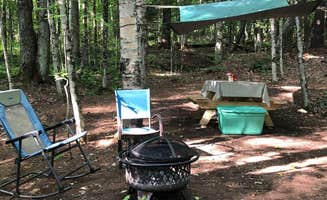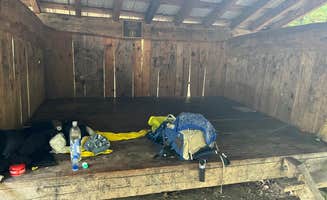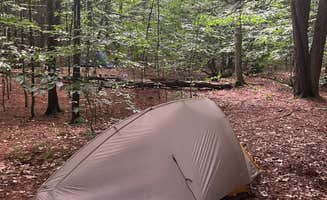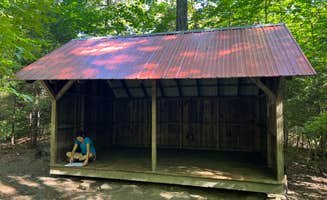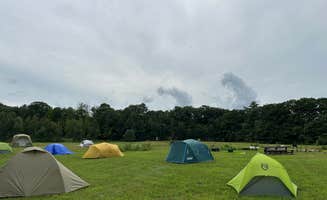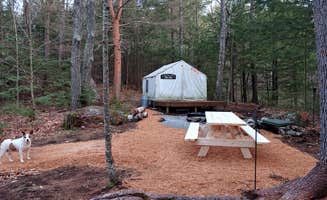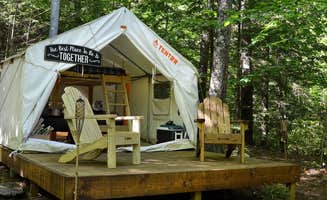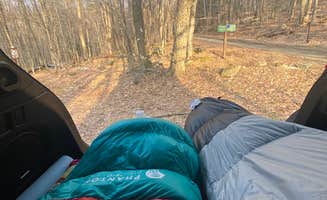Tent camping near Grantham, New Hampshire offers primitive shelter and campsite experiences within the Connecticut River Valley. The area sits between 700-1,000 feet elevation with humid continental climate conditions featuring warm summers and cold winters with moderate precipitation year-round. Backcountry camping in this region typically requires hiking distances between 1-8 miles from trailheads, with limited facilities at destination sites.
What to do
Summit Mount Cardigan: Located approximately 25 miles west of Grantham, this moderate hiking destination features a challenging climb rewarded with panoramic views. Cardigan Campsites provides an ideal basecamp for this adventure. "Great spot to spend the night before a climb of Mt. Cardigan! Or after! The climb is challenging but shouldn't take too long. Great fire tower views at the top too!" notes camper Madison G.
Explore interconnected trail systems: The region offers extensive hiking options connecting to the Appalachian Trail corridor. Happy Hill Backcountry Shelter serves as a convenient overnight stop while traversing these trails. According to Justin P., "The loft was nice since folks could decide to sleep up there while others were down below, either cooking, arriving, or departing."
Seasonal wildlife viewing: Spring and fall migrations bring diverse bird species through the area's forests. Dawn and dusk provide optimal viewing opportunities from camp. For less crowded camping locations, consider weekday visits during shoulder seasons (May-June or September-October).
What campers like
Convenient shelter layouts: Many backcountry sites feature thoughtfully designed accommodations. At Winturri Backcountry Shelter, campers appreciate the organized setup. "The shelter is on the larger side and could fit maybe 6-8 folks. There were lots of tent camping spots as you worked up the hill perpendicular to the shelter," reports Justin P.
Natural water sources: While availability varies seasonally, access to spring water enhances the primitive camping experience. Justin P. notes that at Winturri, "Water was running when I was there in mid-August from a spring close to the shelter."
Campsite privacy options: Multiple tent areas surrounding the main shelters allow campers to choose their desired level of seclusion. At Trapper John Backcountry Campground, there are "a few spots for tenting" outside the shelter area, providing alternatives to communal sleeping arrangements.
What you should know
Seasonal water reliability: Many backcountry sites experience water source fluctuations, particularly during late summer. At Thistle Hill Backcountry Shelter, one camper reported water was available "though it was right after a smaller storm the previous evening," suggesting intermittent availability.
Terrain considerations: Tent sites often require adaptation to forest conditions. Justin P. describes Thistle Hill as having "smaller spots for tent camping that were somewhat sloped," indicating the need for careful site selection.
Facility maintenance varies: Basic privies represent the extent of sanitation facilities at most backcountry sites. Pack out all trash and bring portable water treatment options. Shelters rarely offer power outlets or cellular connectivity.
Tips for camping with families
Start with established campgrounds: For families new to wilderness camping, begin with sites offering more amenities. Sunapee State Park Campground provides electric hookups and reservable sites, creating a more controlled environment for children's first camping experiences.
Pack weather contingencies: The region experiences unpredictable weather patterns year-round. Bring extra layers and rain gear even during summer months. Temperatures can drop below 50°F overnight even in July and August.
Plan realistic hiking distances: When backcountry camping with children, calculate 1 mile per hour of hiking time plus additional breaks. Most shelter sites require a minimum 2-3 mile hike, which can be challenging for younger children carrying gear.
Tips from RVers
Limited RV options: Most camping near Grantham focuses on tent and primitive shelter accommodations with minimal RV facilities. Consider established campgrounds within 10-15 miles for vehicle-based camping.
Road access constraints: Many trailheads leading to backcountry sites feature limited parking and narrow access roads unsuitable for large vehicles. Scout parking options in advance and consider shuttle arrangements for longer stays.
Staff assistance resources: Campground personnel can provide valuable local information. At Cardigan Campsites, one visitor mentioned "Staff is very friendly," suggesting helpful resources for area orientation.


